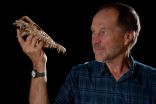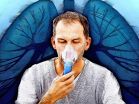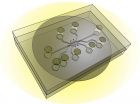(Press-News.org) GAINESVILLE, Fla. --- Many native species have vanished from tropical islands because of human impact, but University of Florida scientists have discovered how fossils can be used to restore lost biodiversity.
The key lies in organic materials found in fossil bones, which contain evidence for how ancient ecosystems functioned, according to a new study available online and in the September issue of the Journal of Herpetology. Pre-human island ecosystems provide vital clues for saving endangered island species and re-establishing native species, said lead author Alex Hastings, who conducted work for the study as graduate student at the Florida Museum of Natural History and UF department of geological sciences.
"Our work is particularly relevant to endangered species that are currently living in marginal environments," said Hastings, currently a postdoctoral researcher at Martin Luther University Halle-Wittenberg. "A better understanding of species' natural roles in ecosystems untouched by people might improve their prospects for survival."
Thousands of years ago, the largest carnivore and herbivore on the Bahamian island of Abaco disappeared. The study reconstructs the ancient food web of Abaco where these two mega-reptiles, the endangered Cuban Crocodile (Crocodylus rhombifer) and the now-extinct Albury's Tortoise (Chelonoidis alburyorum), once flourished. Today, there is no modern terrestrial ecosystem like that of ancient Abaco, with reptiles filling the roles of largest herbivore and carnivore.
In the study, sponsored by the National Science Foundation and National Geographic Society, researchers embarked on the difficult task of reconstructing an ecosystem where few of the components still exist. To understand these missing pieces, scientists analyzed the types of carbon and nitrogen in well-preserved fossil bones from the Cuban Crocodile and Albury's Tortoise, which was unknown to scientists before its 2004 discovery in the Bahamas. The data reveal the crocodile and tortoise were both terrestrial, showing that reptiles "called the shots" on the island, Hastings said.
The terrestrial nature of these creatures is a great indicator of how biodiversity has changed in the Bahamas and what the ideal circumstances would be for these or similar species to return, said Florida Museum ornithology curator and study co-author David Steadman.
"On islands like Abaco that have always been dominated by reptiles, the flora and fauna are more vulnerable because they have evolved to lead a more laid back, island existence," Steadman said. "Understanding this is important to designing better approaches to conservation on the island."
Early paleontological sites in the Bahamas have yielded bones from numerous species of reptiles, birds and mammals that no longer exist on the islands. James Mead, a vertebrate paleontologist with East Tennessee State University, said more research into the evolutionary history of native plants and animals on Abaco is needed as well as conservation programs based on paleontological research that aims to restore these species.
"The Cuban crocodile is living today in small numbers in Cuba, but this new research shows that it is not living to its fullest potential," Mead said. "The crocodile could live more abundantly in a much wider habitat if we allowed it."
INFORMATION:
Other study co-authors are Nancy Albury with the National Museum of the Bahamas and John Krigbaum with UF's department of anthropology.
Answer to restoring lost island biodiversity found in fossils
2014-09-22
ELSE PRESS RELEASES FROM THIS DATE:
Higher risk of heart disease for South Asians in Canada
2014-09-22
Hamilton, ON (September 22, 2014) – South Asians living in Canada have a higher rate of heart disease and double the rate of diabetes compared with while people, McMaster researchers have found.
The paper was published today in the Canadian Medical Association Journal (CMAJ Open) and may be found at http://www.cmajopen.ca/content/2/3/E183.full
One of the fastest-growing ethnic groups in the country is the more than one million South Asian people living in Canada, comprising about three percent of the population. They include people from India, Pakistan, Sri Lanka, ...
Snail shells show high-rise plateau is much lower than it used to be
2014-09-22
The Tibetan Plateau in south-central Asia, because of its size, elevation and impact on climate, is one of the world's greatest geological oddities.
At about 960,000 square miles it covers slightly more land area than Alaska, Texas and California combined, and its elevation is on the same scale as Mount Rainier in the Cascade Range of Washington state. Because it rises so high into the atmosphere, it helps bring monsoons over India and other nations to the south while the plateau itself remains generally arid.
For decades, geologists have debated when and how the plateau ...
Cheater, cheater: UGA study shows what happens when employees feel excluded at work
2014-09-22
Athens, Ga. – When employees feel left out, they act out.
That's the message that new research from the University of Georgia Terry College of Business delivers as it explains why employees can become weasels to benefit their work group.
"Everybody has a need for social approval. It's the basis of our human functioning," said Marie Mitchell, co-author of the research and professor of management at UGA. "But when individuals are faced with a risk of social exclusion, it motivates some pretty unsavory behaviors. We already know how people react when they're definitely ...
Reversing the effects of pulmonary fibrosis
2014-09-22
New Haven, Conn. – Yale University researchers are studying a potential new treatment that reverses the effects of pulmonary fibrosis, a respiratory disease in which scars develop in the lungs and severely hamper breathing.
The treatment uses a microRNA mimic, miR-29, which is delivered to lung tissue intravenously. In mouse models, miR-29 not only blocked pulmonary fibrosis, it reversed fibrosis after several days.
The findings were published Sept. 19 in the journal EMBO Molecular Medicine.
"The mimic, when injected into the blood, goes to the lung and it has a ...
Experts provide much-needed policy analysis for clinical integration of next generation sequencing
2014-09-22
HOUSTON – (Sept. 22, 2014) – As genetic sequencing technologies continue to evolve rapidly, becoming part of clinical care, there is a critical need to establish appropriate policies and regulatory frameworks to address potential challenges, legal and ethical experts have said. A special policy issue of the Journal of Law, Medicine & Ethics published online today and edited by experts with the Center for Medical Ethics and Health Policy at Baylor College of Medicine gives policy makers the tools to jumpstart this process.
Experts with the Center for Medical Ethics and ...
Can tapioca replace corn as the main source for starch sweeteners?
2014-09-22
New Rochelle, NY, September 22, 2014—Cassava, also known as tapioca, has large starch-filled roots and can grow at high yields in areas of Africa, Asia, and Latin America where corn and sugarcane are not commonly grown. With the availability of novel enzymes and processes designed to break down tapioca starch into sugars that can then be used to produce sweeteners such as glucose, fructose, or maltose syrup, tapioca may be an ideal alternative to corn, as described in a Review article in Industrial Biotechnology, a peer-reviewed journal from Mary Ann Liebert, Inc., publishers. ...
Kessler pilot study demonstrates benefits of wellness program for people with MS
2014-09-22
West Orange, NJ. September 22, 2014. Kessler researchers have published a pilot study showing the benefits of a 10-week psychoeducational wellness program in people with multiple sclerosis (MS). Improvements were seen in mood, overall mental health, perceived stress, and pain. "Development and effectiveness of a psychoeducational wellness group for individuals living with MS: Description and outcomes" was epublished ahead of print on September 3 in the International Journal of MS Care (doi: 10.7224/1537-2073.2013-045). The authors are Kimberly Beckwith McGuire, PhD, of ...
Priorities for research on pharmaceutical and personal care products in the environment
2014-09-22
PENSACOLA, Fla. – In 2011 the Society of Environmental Toxicology and Chemistry (SETAC) held a workshop for 45 international experts to identify and prioritize the scientific research needed to understand the risks of pharmaceuticals and personal care products (PPCPs) in the environment. The effort was extended, and results were published in the most recent issue of the Society's international journal, Integrated Environmental Assessment and Management (IEAM). The published work is accompanied by a podcast interviewing the lead author of the study, Murray Rudd from the ...
Wildfires in Khabarovsk Krai, Russia
2014-09-22
Most of the fires captured in this image burn in Khabarovsk Krai, a territory occupying the coastline of the Sea of Okhotsk. Dozens of red hotspots, accompanied by plumes of smoke mark active fires. The smoke, which appears mostly white or grey, blows to the east towards the Sea of Okhotsk. Taiga and tundra are found in the north of this area, swampy forest inhabit the central depression, and deciduous forests are the natural vegetation in the south.
While large wildfires are common in Russia in the summer, the 2014 wildfire season appears to be more intense than usual. ...
New chip promising for tumor-targeting research
2014-09-22
WEST LAFAYETTE, Ind. – Researchers have developed a chip capable of simulating a tumor's "microenvironment" and plan to use the new system to test the effectiveness of nanoparticles and drugs that target cancer.
The new system, called a tumor-microenvironment-on-chip (T-MOC) device, will allow researchers to study the complex environment surrounding tumors and the barriers that prevent the targeted delivery of therapeutic agents, said Bumsoo Han, a Purdue University associate professor of mechanical engineering.
Researchers are trying to perfect "targeted delivery" methods ...







